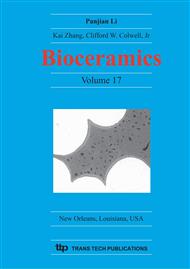p.607
p.611
p.615
p.619
p.623
p.627
p.631
p.635
p.639
In Situ Monitoring of Chondrocyte Response to Bioactive Scaffolds Using Raman Spectroscopy
Abstract:
Septal cartilage is widely used for the repair of soft tissue defects in the head, neck and nose. Tissue Engineering techniques are being investigated to create cartilage in vitro by seeding appropriate cells on resorbable scaffolds. In this study, human chondrocytes were cultured on macroporous bioactive glass foam scaffolds. The aim was to investigate how Raman spectroscopy could be used as a non-invasive technique to monitor the response of chondrocytes to a 3D scaffold in real time. The spectra were compared to scanning electron microscope (SEM) micrographs and immunohistochemistry results.
Info:
Periodical:
Pages:
623-626
Citation:
Online since:
April 2005
Keywords:
Price:
Сopyright:
© 2005 Trans Tech Publications Ltd. All Rights Reserved
Share:
Citation:


